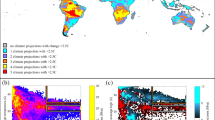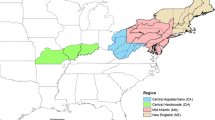Abstract
The susceptibility of agriculture to changing environmental conditions is arguably the most dangerous short-term consequence of climate change, and predictions on the geography of changes will be useful for implementing mitigation strategies. Ecological niche modeling (ENM) is a technique used to relate presence records of species to environmental variables. By extrapolation, ENM maps the suitability of a landscape for the species in question. Recently, ENM was successfully applied to predict the geographic distribution of agriculture. Using climate and soil conditions as predictor variables, agricultural suitability was mapped across the Old World. Here, I present analogous ENM-based maps of the suitability for agriculture under climate change scenarios for the year 2050. Deviations of predicted scenarios from a current conditions model were analyzed by (1) comparing relative average change across regions, and (2) by relating country-wide changes to the data indicative of the wealth of nations. The findings indicate that different regions vary considerably in whether they win or lose in agricultural suitability, even if average change across the entire study region is small. A positive relationship between the wealth of nations and change in agriculture conditions was found, but variability around this trend was high. Parts of Africa, Europe and southern and eastern Asia were predicted to be particularly negatively affected, while north-eastern Europe, among other regions, can expect more favorable conditions for agriculture. The results are presented as an independent “second opinion” to previously published, more complex forecasts on agricultural productivity and food supply variability due to climatic change, which were based on fitting environmental variables to yield statistics.






Similar content being viewed by others
References
Adams RM, Rosenzweig C, Peart RM, Ritchie JT, McCarl BA, Glyer JD, Curry RB, Jones JW, Boote KJ, Allen JH Jr (1990) Global climate change and US agriculture. Nature 345:219–224
Ainsworth EA, Beier C, Calfapietra C, Ceulemans R, Durand-Tardif M, Farquhar GD, Godbold DL, Hendrey GR, Hickler T, Kaduk J, Karnosky DF, Kimball BA, Körner C, Koornneef M, Lafarge T, Leakey ADB, Lewin KF, Long SP, Manderscheid R, Mcneil DL, Mies TA, Miglietta F, Morgan JA, Nagy J, Norby RJ, Norton RM, Percy KE, Rogers A, Soussana JF, Stitt M, Weigel HJ, White JW (2008) Next generation of elevated CO2 experiments with crops: a critical investment for feeding the future world. Plant Cell Environ 31:1317–1324
Araujo MB, New M (2007) Ensemble forecasting of species distributions. Trends Ecol Evol 22:42–47
Austin MP (2007) Species distribution models and ecological theory: a critical assessment and some possible new approaches. Ecol Model 200:1–19
Balvanera P, Pfisterer AB, Buchmann N, He J-S, Nakashizuka T, Raffaelli D, Schmid B (2006) Quantifying the evidence for biodiversity effects on ecosystem functioning and services. Ecol Lett 9:1146–1156
Beck J (2011) Climate wars. Frontiers of Biogeography 3(3):84–85
Beck J, Sieber A (2010) Is the spatial distribution of mankind’s most basic economic traits determined by climate and soil alone? PLoS One 5:e10416. doi:10.1371/journal.pone.0010416
Chen I-C, Hill JK, Ohlemüller R, Roy DB, Thomas CD (2011) Rapid range shifts of species associated with high levels of climate warming. Science 333:1024–1026
Diamond J (2006) Collapse. Viking Books, New York, 575 pp
Dickinson JL (2009) The people paradox: self-esteem striving, immortality ideologies, and human response to climate change. Ecol Soc 14(1):34
Easterling DR, Meehl GA, Parmesan C, Changnon SA, Karl TR, Mearns LO (2000) Climate extremes: observations, modeling, and impacts. Science 289:2068–2074
Elith J, Leathwick JR (2009) Species distribution models: ecological explanation and prediction across space and time. Annu Rev Ecol Evol Syst 40:677–697
Elith J, Graham C, Anderson R, Dudik M, Ferrier S, Guisan A, Hijmans R, Huettmann F, Leathwick J, Lehmann A, Li J, Lohmann L, Loiselle B, Manion G, Moritz C, Nakamura M, Nakazawa Y, Overton J, Peterson A, Phillips S, Richardson K, Scachetti-Pereira R, Shapire R, Soberon J, Williams S, Wisz M, Zimmermann N (2006) Novel methods improve prediction of species’ distributions from occurrence data. Ecography 29:129–151
Elith J, Kearney M, Phillips S (2010) The art of modelling range-shifting species. Methods Ecol Evol 1:330–342
Foley JA, Ramankutty N, Brauman KA, Cassidy ES, Gerber JS, Johnston M, Mueller ND, O’Connell C, Ray DK, West PC, Balzer C, Bennett EM, Carpenter SR, Hill J, Monfreda C, Polasky S, Rockstrom J, Sheehan J, Siebert S, Tilman D, Zaks DPM (2011) Solutions for a cultivated planet. Nature 478:337–342
Fischer G, Shah M, Tubiello FN, van Velhuizen H (2005) Socio-economic and climate change impacts on agriculture: an integrated assessment, 1990–2080. Phil Trans R Soc B (Lond) 360:2067–2083
IPCC (2001) Climate Change 2001. Third Assessment Report. Complete online versions at http://www.grida.no/publications/other/ipcc_tar/ (accessed June 2010)
Körner C (2009) Responses of humid tropical trees to rising CO2. Annu Rev Ecol Evol Syst 40:61–79
Kreyling J, Beierkuhnlein C, Jentsch A (2010) Effects of soil freeze–thaw cycles differ between experimental plant communities. Basic Appl Ecol 11:65–75
Lal R, Pimentel D (2008) Soil erosion: a carbon sink or source? Science 319:1040–1042
Marzban C (2004) The ROC curve and the area under it as performance measures. Weather Forecast 19:1106–1114
Mendelsohn R, Dinar A (1999) Climate change, agriculture, and developing countries: does adaptation matter? World Bank Res Obs 14:277–293
Monfreda C, Ramankutty N, Foley JA (2008) Farming the planet: II. Geographic distribution of crop areas, yields, physiological types, and net primary production in the year 2000. Global Biochemical Cycles 22:1–19
Olesen JE, Bindi M (2002) Consequences of climate change for European agricultural productivity, land use and policy. Eur J Agron 16:239–262
Parmesan C, Yohe G (2003) A globally coherent fingerprint of climate change impacts across natural systems. Nature 421:37–42
Parry ML, Rosenzweig C, Iglesias A, Livermore M, Fischer G (2004) Effects of climate change on global food production under SRES emission and social-economic scenarios. Glob Environ Change 14:53–67
Patz JA, Campbell-Lendrum D, Holloway T, Foley JA (2005) Impact of regional climate change on human health. Nature 438:310–317
Phillips SJ, Anderson RP, Schapire RE (2006) Maximum entropy modeling of species geographic distributions. Ecol Model 190:231–259
Phillips SJ, Dudik M (2008) Modeling of species distributions with Maxent: new extensions and a comprehensive evaluation. Ecography 31:161–175
Quinton JN, Govers G, van Oost K, Bardgett RD (2010) The impact of agricultural soil erosion on biogeochemical cycling. Nat Geosci 3:311–314
Reader J (1998) Africa. Biography of a continent. Penguin, London, 801 pp
Rosenzweig C, Hillel D (2008) Climate variability and the global harvest. Oxford University Press, Oxford, 259 pp
Rosenzweig C, Parry ML (1994) Potential impact of climate change on world food supply. Nature 367:133–138
Samson J, Berteaux D, McGill BJ, Humphries MM (2011) Geographic disparities and moral hazards in the predicted impacts of climate change on human populations. Glob Ecol Biogeogr 20:532–544
Smit B, Skinner MW (2002) Adaptation options in agriculture to climate change: a typology. Mitig Adapt Strateg Glob Chang 7:85–114
Smith J, Smith P, Wattenbach M, Zaehle S, Hiederer R, Jones RJA, Montanarella L, Rounsevell MDA, Reginster I, Ewert F (2005) Projected changes in mineral soil carbon of European croplands and grasslands, 1990–2080. Glob Change Biol 11:2141–2152
Soberon J, Nakamura M (2009) Niches and distributional areas: concepts, methods, and assumptions. Proc Nat Acad Sci 106:19644–19650
van Oost K, Quine TA, Govers G, de Gryze S, Six J, Harden JW, Ritchie JC, McCarty GW, Heckrath G, Kosmas C, Giraldez JV, da Silva JVM, Merckx R (2007) The impact of agricultural soil erosion on the global carbon cycle. Science 318:626–629
Zhang DD, Lee HF, Wang C, Li B, Pei Q, Zhang J, An Y (2011) The causality analysis of climate change and large-scale human crisis. Proc Nat Ac Sci 108:17296–17301
Acknowledgements
W. Schwanghart and M. Curran provided valuable comments on an earlier draft of the manuscript. M. Curran helped with the English presentation, L. Ballesteros with some aspects of modeling. Earlier work in collaboration with A. Sieber provided necessary raw data for this study. The study is part of a project funded by the Swiss National Science Foundation (SNF Grant 31003A_119879).
Author information
Authors and Affiliations
Corresponding author
Electronic Supplementary materials
Below is the link to the electronic supplementary material.
Esm 1
Appendix 1: Model details and alternative GCMs. Appendix 2: Excel-Table with raw data and country-wide averages (PDF 5999 kb)
SUPPLEMENT 2
(XLS 9.65 MB)
Rights and permissions
About this article
Cite this article
Beck, J. Predicting climate change effects on agriculture from ecological niche modeling: who profits, who loses?. Climatic Change 116, 177–189 (2013). https://doi.org/10.1007/s10584-012-0481-x
Received:
Accepted:
Published:
Issue Date:
DOI: https://doi.org/10.1007/s10584-012-0481-x




